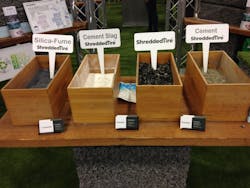The roofing industry is increasingly answering customers’ calls for recycled and recyclable material, including popular roof choices like EPDM, asphalt shingles and metal. Roofing materials like these can be recycled at the end of their life, returning to service on a new roof or finding a new purpose as part of waterproof coatings, pavement and appliances.
One new product spotted at the 2020 International Roofing Expo – ShreddedTire – impacts landfills in a different way. It keeps old tires out of landfills by repurposing them into blocks that can replace both wood blocking and tapered insulation.
[Related: Solutions to Make Your Roof a Walkable Space (IRE 2020)]
How Tires Become Roofs
The blocks begin with ordinary tires that have had the steel removed. The tires are shredded and mixed with water, cement, silica-fume (a byproduct of producing silicon metal or iron-silicon alloys) and cement slag (a type of cement created from the byproducts of iron blast furnaces). The shredded tire/cement mix is molded into one of several options:
- Echo Edge, a replacement for chemically treated wood blocking
- Echo Block, a sloping insulated block that can replace tapered insulation
- Echo Flow, a reverse sloping and permeable block that creates flat walking surfaces for tile and artificial turf
Green roofs can simply leave out the Echo Flow step to create ideal conditions for planting media. The permeable material means you won’t have to budget for drainage in every separate planter.
“That market is growing,” founder Richard Spreen says of green roofs used as occupant amenities. “People want to have running tracks on the roof, dog-walking paths, pools, spas, bars, nightclubs – that’s what we cater to, and we can do all of that and save millions of tires from going to a landfill.”
[Video: IRE 2020 Up close: ShreddedTire, Keeping Tires Out of Landfils]
Why Use Recycled Roofing Materials?
Roofing materials that contain recycled content can help contribute to credits with LEED and other green building rating systems. One credit in LEED’s Materials & Resources category – MR4, Recycled Content – is worth up to two points and requires the project to incorporate 10-20% of its materials from recycled sources.
This percentage is based on cost and weight, so making smart decisions about where to incorporate recycled roofing materials can help meet the requirements for these credits. Other recycled roofing materials that can help earn points for MR4 include pavers, growth media that contains compost and metal roofing.
LEED also offers credits for green roofs, so the permeable recycled roof blocks can contribute to more than one credit if you’re using them to create drainage for a rooftop terrace.
The demand for recycled roof materials is likely to keep growing as building owners and managers increasingly prioritize products with a low environmental impact. The response to this demand is up to the market, and if ShreddedTire’s roofing blocks are any indication, manufacturers are poised to respond.
More about roofing:
About the Author
Janelle Penny
Editor-in-Chief at BUILDINGS
Janelle Penny has been with BUILDINGS since 2010. She is a two-time FOLIO: Eddie award winner who aims to deliver practical, actionable content for building owners and facilities professionals.

